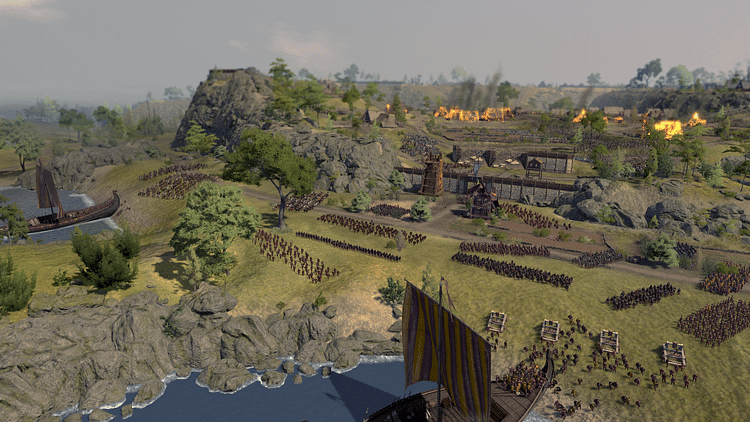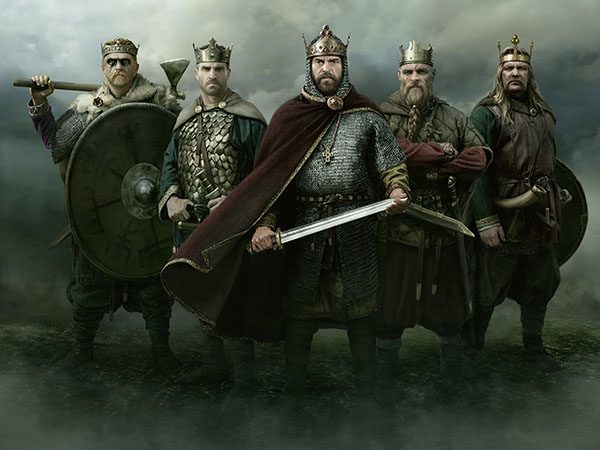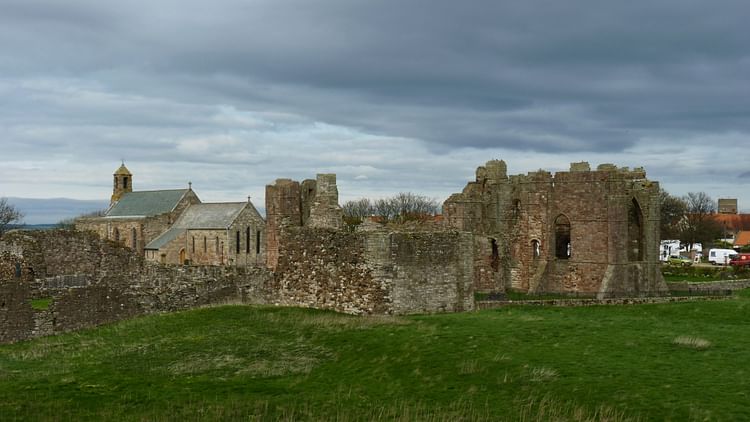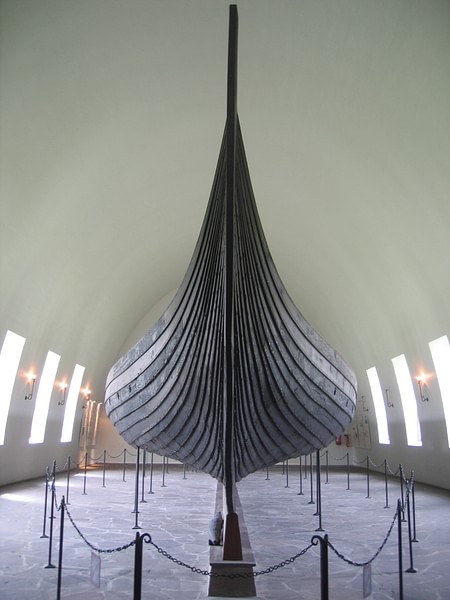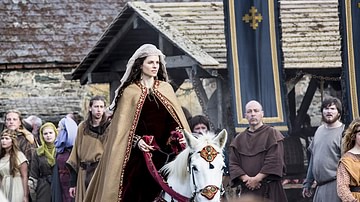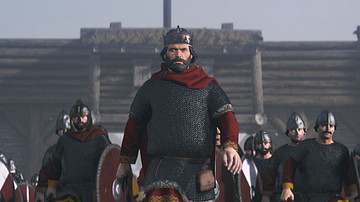The Viking raids and subsequent settlements define the period known as the Viking Age in Britain which had profound consequences on the development of the culture and language. The raids started in June of 793 CE when three ships docked at the shore by the abbey of Lindisfarne. The abbey's reeve, Beaduheard, believed he recognized them as those of Norse traders and, thinking they had lost their way, went out to direct them up the coast to the estate he thought they had been aiming for. Upon approaching the ships, however, he was instantly killed by the sailors who then sacked the abbey and murdered everyone they found inside or on the grounds; this was only the beginning.
The raids continued in 794 CE when Viking ships sacked the monastery of Jarrow in Northumbria, in 795 CE when they struck at the monastery of Iona in Scotland and, in the same year, attacked sites in Ireland. Raids and military incursions continued in Britain through c. 1066 CE, ending with the invasion by the great Norwegian king Harald Hardrada (1046-1066 CE), known as “the last of the Vikings”, whose victories over the Anglo-Saxon king Harold Godwinson (1066 CE) contributed significantly to William the Conqueror's Norman victory over Harold at The Battle of Hastings later in the same year.
The Vikings were all from Scandinavia but the term did not designate a homogeneous group; rather, it referred to one who joined an expedition expressly for the purpose of raiding others for personal gain. The Old Norse phrase fara i viking (meaning “to go on expedition”) is understood as meaning something closer to piracy and robbery than legitimate trade.
Although the Vikings may have begun as little more than pirates in Britain, they would eventually arrive as great armies under skilled military leaders, establish communities, and assimilate with the population. The Viking Age is known for legendary Norse leaders such as:
- Halfdan Ragnarsson (also known as Halfdane, c. 865-877 CE)
- Ivar the Boneless (c. 870 CE), Halfdan's brother
- Guthrum (c. 890 CE)
- Harold Bluetooth (c. 985 CE)
- Sven Forkbeard (986-1014 CE), Harold's son
- Cnut the Great (1016-1035 CE)
- Harald Hardrada (1046-1066 CE)
Other notable Norse explorers of the time were Eric the Red (died 1003 CE) and Leif Erikson (died c. 1020 CE) who explored and settled Greenland and North America.
In Britain, this was also the period of famous rulers such as Alfred the Great (871-899 CE), Edward the Elder (899-924 CE), and Queen Aethelflaed of the Mercians (911-918 CE) among others while, in France, it was the time of Charlemagne (800-814 CE) whose efforts at Christianizing the “heathen” Norse have been recognized as contributing to the ferocity of the Viking raids in Britain and elsewhere.
Reasons for the Raids
The primary reason given by medieval historians for the Viking raids was God's displeasure at the people's sin and selfishness. The scribe Alcuin (died c. 804 CE) epitomizes this view in a letter from 793 CE to Aethelred, King of Northumbria in which he complains about the moral decline of the country and attributes the Viking raid at Lindisfarne to God's wrath:
What may I say about avarice, robbery, violent judgments? – when it is clearer than day how much these crimes have increased everywhere and a despoiled people testifies to it. Whoever reads the Holy Scriptures and ponders ancient histories and considers the fortune of the world will find that for sins of this kind kings lost kingdoms and peoples their country; and while the strong unjustly seized the goods of others, they justly lost their own. (Somerville & McDonald, 186).
The Anglo-Saxon Chronicle likewise attributes the raid to a supernatural cause. The entry for the year 793 CE reads:
In this year, terrifying omens appeared over Northumbria and the people were wretchedly afraid. There were huge flashes of lightning and terrifying dragons were seen flying in the air. A great famine followed these signs and shortly after that, on the sixth day before the Ides of January, the miserable raiding of heathens destroyed God's church on the Isle of Lindisfarne through plundering and murder. (Somerville & McDonald, 184).
The scribe Dudo (died c. 1027 CE) attributed the raids to overpopulation in Scandinavia and the generally depraved state of the “barbarians” who were forced to find new areas to inhabit overseas:
Now these people burn with too much wanton lasciviousness and with singular depravity debauch and mate with as many women as they please; and so, by mingling together in illicit couplings, they generate innumerable children. When these have grown up, they clamor fiercely against their fathers and their grandfathers, or more frequently against each other, for shares of property; and, as they are over-many, and the land they inhabit is not large enough for them to live in, there is a very old custom by which a multitude of youths is selected by lot and expelled into the realms of other nations, to win kingdoms for themselves by fighting. (Somerville & McDonald, 182-183)
This last suggestion gained credence with later writers and became the standard explanation for the Viking raids, but there is no more evidence for it in historical events than the wrath-of-god explanation. The clearest cause for the Viking raids was simply the acquisition of wealth. Britain, especially, was well known for its lucrative trade centers, and the Scandinavians were aware of this through their own commerce with the region.
The first sites struck were all religious institutions but this seems to have had more to do with convenience than any other consideration; the abbeys and priories which first fell to the Vikings were located near the coast. Although the Anglo-Saxon Chronicle gives a January date for the raid on Lindisfarne, other sources make clear it was in June, and this would make sense as the seas would have been calmer and provided greater ease in travel. It would have been pointless to go further inland upon reaching Britain when there were such easy targets within range of the sea, and the Lindisfarne Priory was an exceptionally wealthy one.
Lindisfarne had been founded in c. 635 CE and became the most important pilgrimage site in the region following reports of miracles associated with the bishop St. Cuthbert (c. 634-670 CE) who presided there. St. Cuthbert was credited with all manner of miraculous events after his death when the monks, who had opened his coffin, found his body in a perfect state of preservation and elevated him to sainthood.
Following this event, people regularly came to Lindisfarne to pray to the saint, receive answers to these prayers, and further invoke his protection for themselves and their communities; in return, they gave the priory rich gifts – as much as they could afford – in thanks for continued miracles and protection. The Viking raid on this particular religious community, then, was especially devastating because St. Cuthbert had obviously failed to protect his own people in the priory and so there seemed little chance he would do better for others.
In the same way that the Huns had struck unexpectedly and brutally against the eastern cities of the Roman Empire in the 5th century CE, the Vikings now did in Britain. As with the Huns, there was no way to prepare for an attack, no understanding of where the adversary came from, and no discernible motive other than slaughter and robbery. The savagery of the unwarranted attacks, especially on religious institutions, encouraged the belief that the Vikings had been sent by God to punish the people for their sins; in much the same way Attila the Hun was designated the “scourge of God” by the prelates of his time. This new scourge, it was thought, was sent to destroy the shepherds of the Christian flock in Britain which would then lead to the destruction of everything else. 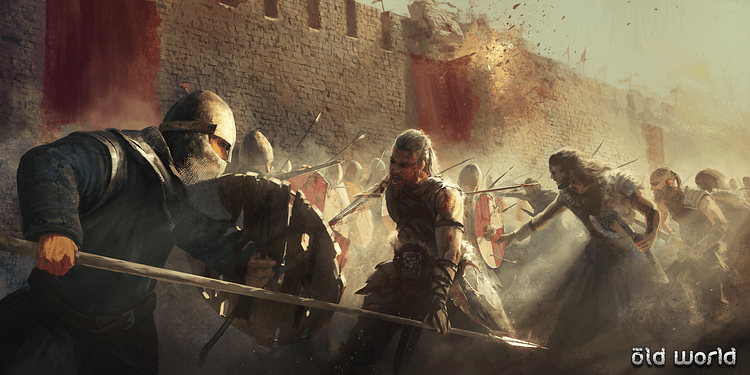
Religious Influence on Raids
It does not seem likely that the Vikings were targeting religious communities for any reason other than convenience, however. Far from targeting Lindisfarne for its religious association, the Vikings would have chosen it for its riches or, as scholar Janet T. Nelson observes, “what lured Vikings was movable wealth” (Sawyer, 36). The rich gifts given to Lindisfarne in thanks for answered prayers were, naturally, unprotected as the monks had no weapons nor any need for them. Similar religious communities followed this same paradigm and so made tempting targets for Viking raiders.
At the same time, however, religion did play a part in these raids, and this aspect is intimately tied in with trade and migration. In c. 2300 BCE Germanic-speaking peoples migrated to Scandinavia bringing with them their religious beliefs in fierce gods who rewarded brave heroes in battle. This period is known as the beginning of the Bronze Age (c. 2300 - c. 1200 BCE) in which people began manufacturing tools and weapons from bronze, an alloy of copper and tin. Increased need for these materials forced the Scandinavians to engage in long-distance trade with Europe and the Mediterranean which brought them into close contact with these other cultures.
In time, a number of Scandinavian traders established permanent communities in Europe and became Christianized while their families and neighbors back home continued to hold to their ancestral belief in the Norse gods. Professor Kenneth Harl notes that by 625 CE:
The West Germanic kinsmen of the Scandinavians had converted to Christianity and had begun to forget their own stories. Between 650 and 700 CE, new Christian cultures emerged in England, in the Frankish world, and in Frisia, which led to a parting of the ways between the Scandinavian heartland and the new states in the former Roman Empire. (25)
While these Scandinavian communities developed as Christians, the belief in the Norse gods back home did likewise. By the time of the 2nd-3rd centuries CE, the Norse god Odin had been elevated to a position of supremacy in the pantheon of Scandinavian religion, and Odin would become “the quintessential god of the Viking Age” (Harl, 15). Odin was the god of war, battle, military victory but also presided over thought, reason, poetry, song, and logic.
Those who followed him devoutly would come to be known as “berserkers” who fought fiercely in battle without any apparent fear of death. They did so because of their recognition of the gifts Odin had given them in life and their belief in the rewards which awaited them after death. According to Norse mythology, these heroes lived on in Odin's hall of Valhalla, feasting and drinking when they were not honing their martial skills, in preparation for the final cataclysmic battle of Ragnarok, the end of the known world. Odin wanted only the best warriors for this final engagement with the forces of chaos but also needed as many as he could muster. Proficiency in battle, therefore, became one of the defining and most highly valued skills for the Vikings, followers of Odin.

Since their kinsmen had neglected the old faith in favor of the new Christianity, there were no bonds of ancestry or honor to be considered when the Vikings encountered the people of Britain or elsewhere. It would have been considered dishonorable for a warrior to murder unarmed men – as happened at Lindisfarne – but only under certain conditions. One could not kill one's kinsmen without sound provocation or kill someone who had surrendered in battle (although there is ample evidence of this happening) but this consideration did not apply to those outside of the faith living in other countries.
The religion of the Norse, therefore, encouraged the raids in Britain which brought not only personal wealth and possible earthly fame but also immortality, should one die in battle, and the promise of a place in Odin's elite army for the battle at the end of the world. None of these raids would have possible, however, were it not for the skill the Scandinavians developed in woodworking and, especially, in building ships capable of making these voyages.
Shipbuilding
Rock carvings from Scandinavia dated to c. 4000-2300 BCE indicate that the people already knew how to build boats, driven by paddles, to navigate their coasts. Shipbuilding developed past this stage of essentially small ferry boats only around c. 300-200 BCE and would not develop further until interactions with Roman traders – as well as Celtic and Germanic merchants using Roman technology – c. 200-400 CE.
Professor Harl notes that the “first major ship we have is the Hjortspring ship from Als, an island off Denmark, dating from about 300-200 BCE” (42). This ship, however, follows the rudimentary design of the past and is powered by paddles. The first ship able to navigate the sea is known as the Nydam ship, also from Denmark, c. 350-400 CE.
Harl notes that “the most important innovation of the Romans was the sail” (43). It would be the sail which enabled the Vikings to travel the seas as they did and raid as they pleased. The other important aspect was the keel which was developed in the early 8th century CE as well as the keelson, a thick base which could support a large mast and sail. Harl describes one of these later ships:
The Gokstad burial ship (c. 900-905 CE) is a warship; it is 75 feet [23 m] long and had a keel and keelson capable of carrying a mast close to 45 feet [14 m] in height. The sail might have been 750-825 square feet [70-77 square meters]. This ship is a brilliant piece of work in combining strength and flexibility. All such Viking Age ships were built to ride the water, rather than to fight the waves. (44)
In these ships, the Vikings made their voyages from the coasts of Scandinavia to the regions known today as Britain, Scotland, Ireland, France, Germany, Italy, and other areas of the Mediterranean.
Armies & Settlements
The early raids and the rich plunder they generated encouraged more elaborate military expeditions. In 865 CE the Great Army under the leadership of Halfdane and Ivar the Boneless arrived in East Anglia in a massive fleet and marched across the land. In 867 CE the city of York fell, in 868 CE Mercia was raided, and by 871 CE Halfdane had defeated every force sent against him and was so powerful that Alfred the Great had no choice but to pay him an exorbitant amount to leave Wessex.
Alfred's payment did not mean the Vikings had to leave Britain, however, and Halfdane continued exercising his power after Ivar the Boneless had gone home. He put down rebellions in his territories and established Danish legal practices and customs so that, by 875 CE, he had created a Viking kingdom in Britain and partitioned lands in Yorkshire as rewards for his veterans. In 879 CE he was powerful enough to be able to install Ceowulf II (r. 874-883 CE) as a puppet-king in the Kingdom of Mercia. His policies were continued by the warlord Guthrum who ravaged Wessex until his defeat by Alfred the Great at the Battle of Eddington in 878 CE which resulted in the partitioning of Britain into the kingdom of Wessex under Alfred and the region of the Danelaw under Halfdane in East Mercia and Guthrum who took East Anglia.
In the TV series Vikings, the Viking conquest of Britain is compressed and various events are switched around or telescoped in the interests of the narrative. Ragnar Lothbrok never made the kinds of inroads into Britain as depicted in the show and never made any contracts or treaties with Egbert of Wessex regarding Mercia or the return of Queen Kwenthryth to the Mercian throne. The sequence in Season 3:5 where Aethelwulf massacres the Norse settlement in Wessex is fictionalized but raids on Norse settlements by Anglo-Saxons or West Saxons did occur very much along the lines of that episode. Even so, there were numerous communities established by the Vikings which thrived and grew.
While other Viking armies and explorers were busy expanding Scandinavian influences throughout the rest of the world, those who had settled in Britain went about domestic tasks as they would have once done back home. The Danelaw region operated under laws familiar to the Vikings, and they continued to observe their old religion. Back home in Denmark, however, the king Harold Bluetooth had converted the Danes to Christianity which his son, Sven Forkbeard, objected to. Possibly because of this religious difference – though clearly influenced by other factors as well – Sven deposed his father.
The Viking Legacy
Sven invaded Britain, allegedly in response to a massacre of the Danes there, in 1013 CE. His son, Cnut, marched with him as a commander of part of the force. After Sven's death in 1015 CE, Cnut was proclaimed king of Denmark and united it with Britain under his rule. He would afterwards claim the thrones of both Norway and Sweden and bring those regions tightly under his control. Later historians refer to Cnut the Great as one of the most effective rulers of the Viking Age – or even any age – for his legal precepts and skill in both military and political spheres.
The last great Viking king, Harald Hardrada, rose from modest beginnings to serve in the prestigious Varangian Guard for the Byzantine Emperor and eventually become king of Norway. His invasion of Britain in 1066 CE did not result in winning the crown, as he had hoped, but significantly weakened the Anglo-Saxon forces under Harold Godwinson to the point where William the Conqueror's victory was almost assured at the Battle of Hastings.
The Norman Conquest of Britain in 1066 CE sent immigrants fleeing from their land to all parts of the western world, influenced the language and culture of the British Isles, and essentially set the course for the development of the west from that point forward. That conquest was made possible by the Viking invasion which preceded it, and the culture of the British Isles had developed from 793 - c. 1066 CE in response to Viking raids, assimilation, culture, and law. The world today, in fact, would be unrecognizable without the Vikings raids. Although they began as an easy means to wealth and personal glory, the Viking raids on Britain would come to define the culture not only of that region but of the western world.
